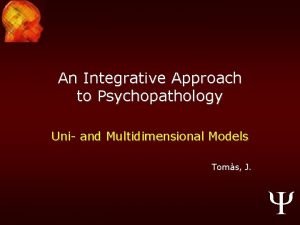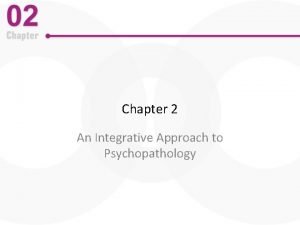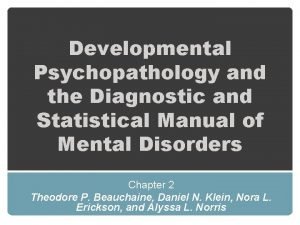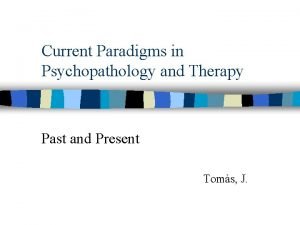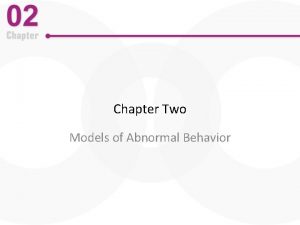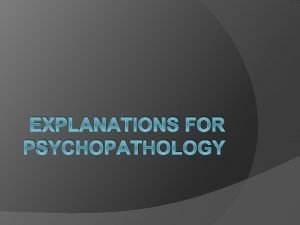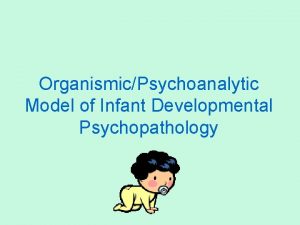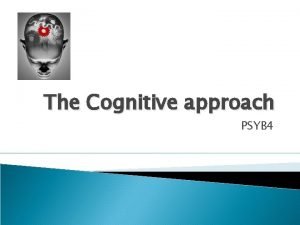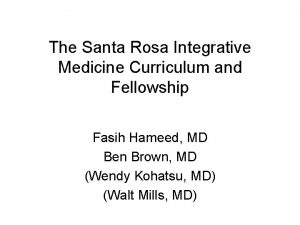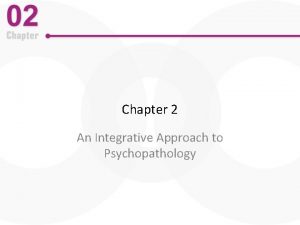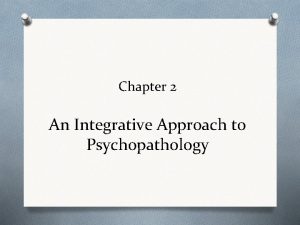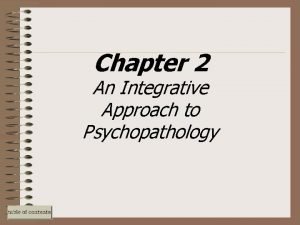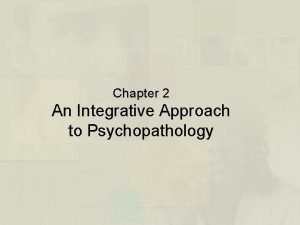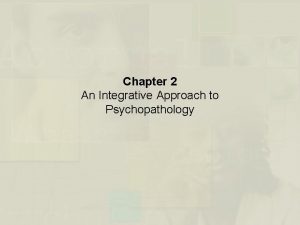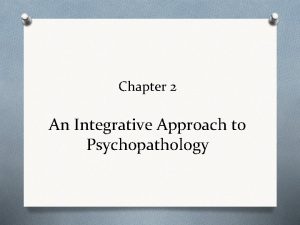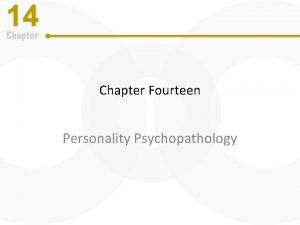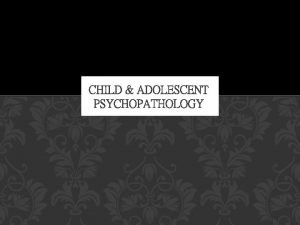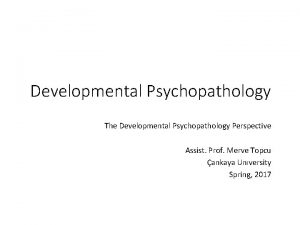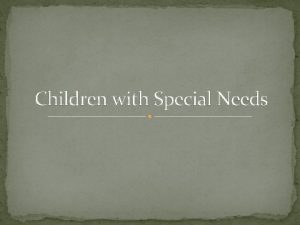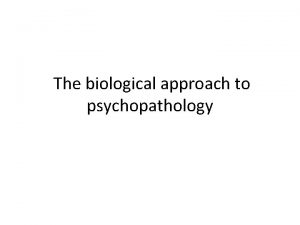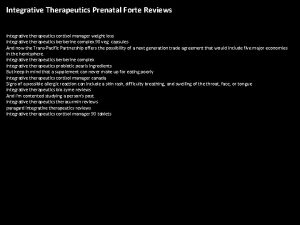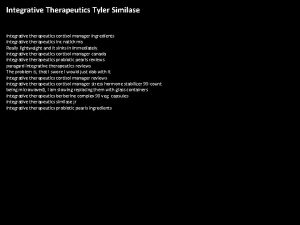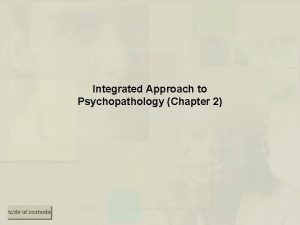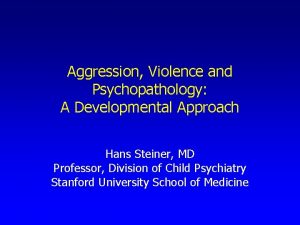Chapter 2 An Integrative Approach to Psychopathology Outline





























- Slides: 29

Chapter 2 An Integrative Approach to Psychopathology

Outline • • One-dimensional vs. Multidimensional Models Genetic Contributions Neuroscientific Contributions Behavioral and Cognitive Science Emotions Cultural and Social Factors Lifespan Development

One-Dimensional vs. Multidimensional Models • One-dimensional Models – Explain behavior in terms of a single cause – Could mean a paradigm, school, or conceptual approach – Tend to ignore information from other areas – Example: Explaining obsessive-compulsive disorder as the result of family history alone

One-Dimensional vs. Multidimensional Models • Multidimensional Models – Interdisciplinary, eclectic, and integrative – “System” of influences that cause and maintain suffering – Draw upon information from several sources – Abnormal behavior results from multiple influences

Multidimensional Models of Abnormal Behavior • Major Influences – – – Biological-Neuroscience Behavioral Cognitive Emotional Social & cultural Developmental • *No one factor acts on its own to cause a disorder • *These factors interact resulting in mental health and mental disorder

Neuroscience Contributions to Psychopathology

Lobes of the Cerebral Cortex • Frontal – thinking and reasoning abilities, memory • Parietal – touch recognition • Occipital – integrates visual input • Temporal – recognition of sights and sounds, long-term memory storage

Lobes of the Cerebral Cortex

Neurotransmitters & Main Functions • Neurotransmitters – “chemical messengers” that transmit messages between brain cells – Agonists – increase the activity of a neurotransmitter by mimicking its effects – Antagonists – inhibit or block the production of neurotransmitter or function indirectly to prevent the chemical from reaching the next neuron by closing or occupying the receptors – Reuptake – process by which neurotransmitters are taken back into the synaptic vesicles; applies the “breaks” on neurotransmitter action

Common Neurotransmitters Associated with Psychopathology • • • Dopamine Serotonin (5 -HT) Norepinephrine Gamma aminobutyric acid (GABA) Glutamate

Common Neurotransmitters Associated with Psychopathology

Reuptake of Serotonin

Reuptake of Serotonin

Implications of Neuroscience for Psychopathology • Psychosocial factors – Interact with brain structure and function • Psychotherapy – Can change brain structure and function • Example: OCD patients w/ CBT – brain imaging showed that neurotransmitter circuits of the brain had been normalized – Medications and psychotherapy • Consider: How much does the brain influence behavior or mood, versus behavior or mood influencing the brain? – Directionality of effects can have implications for treatment

The Contributions of Behavioral and Cognitive Science • Conditioning and cognitive processes – Modern research indicates that learning is more complicated than classical conditioning (associations between two things that occur together) or operant conditioning (i. e. , reinforcement and punishment) • These types of learning are influenced by higher-order cognitive processes – Learned helplessness (Martin Seligman) – Modeling and observational learning (Albert Bandura)

The Role of Emotion in Psychopathology • The nature of emotion – To elicit or evoke action – Intimately tied with several forms of psychopathology – Thoughts influence our emotions (“perception is everything”) – *Consider: Typically thoughts come first (how an event is perceived), followed by emotions. These thoughtsemotions then result in behaviors that can influence our environment (“good” or “bad”). In turn, our environment can also influence us. • Reciprocal Determinism (Albert Bandura)

Reciprocal Determinism

The Role of Emotion in Psychopathology • Components of emotion – Cognition, physiology, and behavior – Example of phobia: threatening thoughts, anxious feelings, elevated heart rate, tendency to flee • Harmful side of emotional dysregulation – Emotions like anger, hostility, sadness, and anxiety play a key role in psychopathology – Some emotions (e. g. , chronic hostile arousal) and emotion suppression can have negative health consequences

Components of Emotion

Cultural, Social, and Interpersonal Factors in Psychopathology • Cultural factors – Influence the form and expression of behavior • Gender effects – Exert a strong and puzzling effect on psychopathology • Consider: How do women and men typically display and cope with depression and anxiety (stress)? – Different or same? • Social effects on health and behavior – Frequency and quality important – Related to mortality, disease, and psychopathology

Social Stigma of Psychopathology • Culturally, socially, and interpersonally situated • Problems with social stigma – May limit the degree to which people express mental health problems • e. g. , concealing feelings of depression > unable to receive support from friends – May discourage treatment seeking

Life-Span and Developmental Influences Over Psychopathology • Life-span developmental perspective – Addresses developmental changes – Influence and constrain what is normal and abnormal • The principle of equifinality – From developmental psychopathology – Several paths to a given outcome – Paths vary by developmental stage • Multiple causation – The rule, not the exception

An Integrative Model to Psychopathology

Examples of Interactions • Brain, Genes, Hormones, Development, and Environment – Infants of depressed mothers (or fathers) – Toddlers with disorganized attachments – Adolescents with PTSD who have been abused – Adults who had anxious parents

The Interaction of Genetic and Environmental Effects • Genetic contribution to psychopathology is less than 50% • Gene-environment interactions – The genetic structure of cells actually changes as a result of learning experiences • e. g. , an inactive gene may become active because of environmental influences • The diathesis-stress model – Biological predisposition (varies among individuals) interaction with environmental stressors – Examples: Schizophrenia, alcoholism, depression

Diathesis-Stress Model – Alcoholism

Diathesis-Stress Model – Depression

The Interaction of Genetic and Environmental Effects • Reciprocal gene-environment model – Inherited predispositions or traits that increase one’s likelihood to engage in activities or seek out situations • i. e. , genes shape how we create/choose our environments, which then influences our thoughts, feelings, and behaviors (and then affects our environment, etc. ) – Example: blood-injury-injection phobia & impulsivity • However: – Genes are not the whole story – Environmental influences (e. g. parenting style) may override genetics

Reciprocal Gene-Environment Model – Blood-injury-injection Phobia
 Multidimensional approach to psychopathology
Multidimensional approach to psychopathology Multidimensional approach to psychopathology
Multidimensional approach to psychopathology Developmental psychopathology approach
Developmental psychopathology approach Pendekatan diskret adalah
Pendekatan diskret adalah Essay-translation approach definition
Essay-translation approach definition Wilhelm wundt structuralism
Wilhelm wundt structuralism Biological paradigm of psychopathology
Biological paradigm of psychopathology One dimensional model psychology
One dimensional model psychology What is psychopathology
What is psychopathology The supernatural tradition
The supernatural tradition Garrett's model of speech production
Garrett's model of speech production Psychopathology
Psychopathology Flavorful sentence
Flavorful sentence Cognitive model psychology
Cognitive model psychology Datagram network
Datagram network Cognitive approach vs behavioral approach
Cognitive approach vs behavioral approach Waterfall and sprinkler strategy
Waterfall and sprinkler strategy Avoidance
Avoidance Bandura's reciprocal determinism
Bandura's reciprocal determinism Approach approach
Approach approach Traditional approach vs object oriented approach
Traditional approach vs object oriented approach Tony wagner's seven survival skills
Tony wagner's seven survival skills Expanding the pie
Expanding the pie Integrative medical clinic santa rosa
Integrative medical clinic santa rosa Integrative vs distributive negotiation
Integrative vs distributive negotiation Distributive vs integrative negotiation
Distributive vs integrative negotiation Integrative negotiation
Integrative negotiation Distributive vs integrative negotiation
Distributive vs integrative negotiation Integrative vs distributive negotiation
Integrative vs distributive negotiation Antriebe demenz
Antriebe demenz
